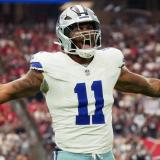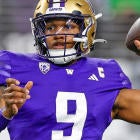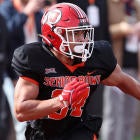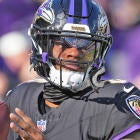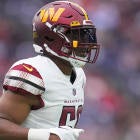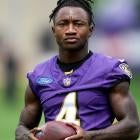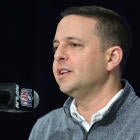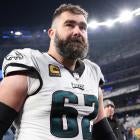It was frigid. It was brutal and ugly. It was a slug-it-out, defensive, grind-it-out kind of game.
The Seahawks-Vikings opening round playoff game Sunday wasn't ordinary. Yet the Seahawks, beaten to a bloody, frozen pulp for three quarters, won in vintage Seahawks fashion, rallying from a two-score, fourth-quarter hole to stun the Vikings and those who braved the negative temperatures at TCF Bank Stadium. The sixth-seeded Seahawks left Minnesota with a 10-9 win, advancing to the divisional round of the playoffs where they'll face the 15-1 Panthers next weekend.
In the third-coldest game on record, the Vikings defense manhandled the Seahawks in the trenches, pounding Russell Wilson. Capitalizing on costly Seahawks mistakes and utilizing the then-reliable right foot of Blair Walsh, the Vikings slowly built a 9-0 lead entering the fourth quarter.
But the Seahawks rallied in the negative-degree weather, taking a 10-9 lead thanks to a crazy ad-libbed play from Wilson, which led to a Doug Baldwin touchdown, and a costly Adrian Peterson fumble, which the Seahawks converted into the winning points. From there, the Seahawks' defense turned up the heat and relied on some last-second luck.
Let's break it all down.
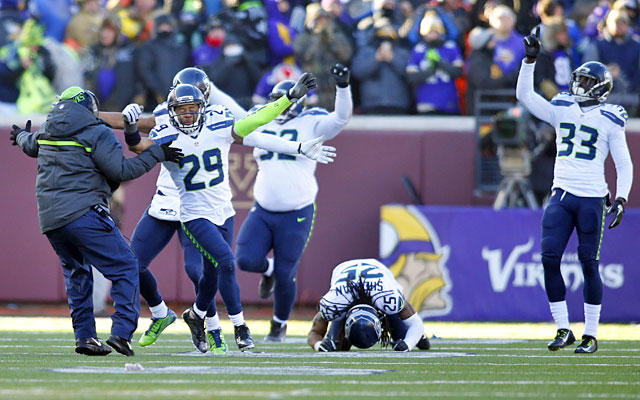
1. Seattle's fourth-quarter magic
When Walsh nailed his third field goal of the game, giving the Vikings a nine-point lead in the third quarter, the Vikings appeared to be on their way to a controlling win. And then Russell Wilson happened.
Driving into Vikings territory in the fourth quarter, Wilson came up with a season-saving play when a shotgun snap flew past him and onto the other side of the 50-yard line. Wilson slid to his knees and recovered the fumble at his own 45-yard line. In typical Wilson fashion, he somehow escaped an onslaught of defenders and found Tyler Lockett down the field.
Wilson turned a potential back-breaking negative play into a huge gain, giving Seattle an extra breath.
Only Russell Wilson could take a botched snap and sure-fire 20-yard loss.. And turn it into a 35-yard pass. WOW. https://t.co/Xqlty0CGqp
— NFL (@NFL) January 10, 2016
Two plays later, Wilson accounted for the game's only touchdown when he found Baldwin in the end zone.
Then, the tide really turned. With a chance to pad their lead and ice the game, the Vikings turned to Peterson. But Peterson couldn't hang onto the ball.
Kam Chancellor stripped Peterson and gave the Seahawks a chance to steal the game.
Kam Chancellor is too strong: https://t.co/KMBYt3psnr pic.twitter.com/em80lMKbTY
— SB Nation (@SBNation) January 10, 2016
Adrian Peterson on the sideline after the fumble. pic.twitter.com/9T5iynN28o
— MarcusD (@_MarcusD_) January 10, 2016
The Seahawks didn't waste the opportunity, kicking a field goal to earn a one-point advantage. The two teams traded punts twice before the Vikings' fateful drive. Starting at their own 39-yard line with 1:42 showing on the game clock, the Vikings made their way down the field thanks to a pass interference penalty and shoddy tackling, which allowed Kyle Rudolph to pick up 24 yards on a short pass.
The Vikings, situated at the 18-yard line, milked the clock and inched closer to the end zone, eventually settling for a chip-shot from the Seahawks' 9-yard line. With 26 seconds left, Walsh -- perfect on his first three kicks -- stepped up to send the Vikings to the next round.
Instead, he shanked it. Walsh, who overcame some poor holds on his previous kicks, couldn't handle another subpar hold, pulling the kick way wide, sealing the Seahawks' win.
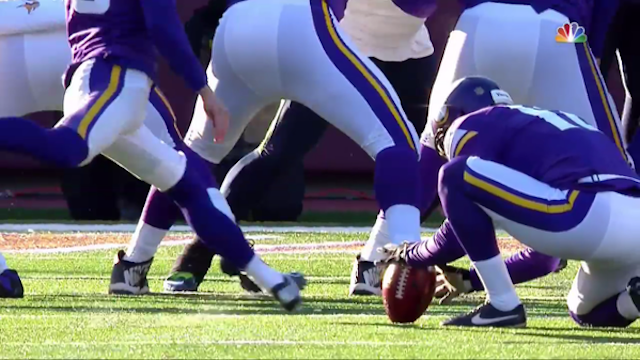
But Vikings head coach Mike Zimmer didn't let Walsh, who was reportedly sobbing after the game, off the hook.
"It's a chip shot," Zimmer said, according to Around the NFL. "He's got to make it."
Walsh accepted the heat, though his teammates refused to blame him.
Blair Walsh took all blame for his missed kick, said repeatedly that he let team down. Walsh broke down crying as teammates consoled him
— chipscoggins (@chipscoggins) January 10, 2016
Jeff Locke blamed himself for not spinning the ball to get the laces out. Said laces were staring at Walsh when he kicked it.
— chipscoggins (@chipscoggins) January 10, 2016
Many Vikings teammates visited Walsh at his locker to offer support. Said Harrison Smith: "We're not going to abandon him."
— chipscoggins (@chipscoggins) January 10, 2016
2. Defense wins
The missed kick and the drama of the final few minutes will overshadow every other storyline, but this game belonged to both defenses.
Entering the game, one of the key matchups figured to be Minnesota's run game vs. Seattle's run defense. Adrian Peterson won the regular season rushing title with 1,485 yards or 92.8 yards per game. The Seahawks allowed just 81.5 rushing yards per game -- the best mark in the league.
On Sunday, Peterson was limited to just 45 yards on 23 carries. As a whole, the Vikings' offense racked up 183 yards for an average of 3.3 yards per play. The Seahawks' offense didn't fare much better, going for 226 yards -- an average of 4.0 yards per play.
Though the Vikings' defense held Seattle in check, they failed to come up with game-changing plays (see: Wilson's botched-snap pass above). The Seahawks' defense, on the other hand, didn't let the Vikings into the end zone.
In the first half, Seahawks safety Earl Thomas prevented a touchdown, demonstrating his incredible range by jarring the ball loose on a deep ball intended for a seemingly open Jerick McKinnon.
BOOM @Earl_Thomas #gohawks #SEAvsMIN #SeahawksNation #seahawks pic.twitter.com/tRDpsz0gR8
— Baby the Yorkie (@dababyyorkie) January 10, 2016
In fact, you could argue all nine of the Vikings' points were only scored due to Seattle's sloppiness, which brings us to ...
3. Seattle overcomes critical mistakes
On the Seahawks' first drive, they failed to pick up a first down. On fourth down, a low snap forced punter Jon Ryan to abandon his punt. Ryan opted to run (and eventually hurdle) for the first down. Ryan got stopped short of the line to gain, and the Vikings were in business.
It definitely looked like Ryan could have gotten the punt away.
Jon Ryan grabs the low snap and takes off, tries to hurdle. pic.twitter.com/gaCSjXUjOd
— MarcusD (@_MarcusD_) January 10, 2016
The Vikings cashed in with three points.
Then, the Seahawks ran out of timeouts with 12:41 remaining in the first half, wasting one timeout on defense before a Minnesota punt and burning two due to play-clock issues.
With under six minutes remaining in the first half, the Seahawks were seemingly in field goal range and were set to tie the game. But a delay of game penalty on third down backed the Seahawks to the 33-yard line. After a short pass on the ensuing play, the Seahawks decided to go for it on fourth down instead of attempting a field goal from the 30-yard line.
Given the weather conditions, that decision made sense. But the Seahawks' play call didn't make any sense. On fourth-and-13, Wilson threw a pass way short of the sticks, picking up just 7 yards. If they were going to throw short, why didn't they just punt to maximize field position? And if they were going to go for it, why didn't they take a deep shot? An interception wouldn't have hurt the Seahawks in that situation and it would've given them a chance to score a touchdown or pick up a first down via a defensive penalty.
Still, at the tail-end of the half, the Seahawks were given a chance to take a 7-3 lead. On third down from the Vikings' 38-yard line, Baldwin slipped past the Vikings' defense near the goal line.

With an accurate and on-time throw, Baldwin would've scored with ease. Instead, Wilson's throw resembled a shanked punt. The hang time allowed the Vikings' defenders to recover and break up the play. Seattle entered halftime with no points.
Things didn't get better after the break. To open up the third quarter, the Seahawks burned their first timeout on their opening drive. On fourth-and-3 at the Vikings' 40-yard line -- with the Vikings clearly confused -- the Seahawks were too slow getting to the line of scrimmage. They took the timeout with the play clock at zero.
Wilson threw a pick to Trae Waynes on the next play.
Russell Wilson intercepted off the tipped pass pic.twitter.com/gPw2WG9GjH
— MarcusD (@_MarcusD_) January 10, 2016
On the ensuing drive, a roughing the passer penalty on Cliff Avril moved the ball deep into Seahawks' territory. The Vikings kicked another field goal.
Even on the Vikings' third field goal of the game, the Seahawks could've prevented the ball from clearing the line of scrimmage. Richard Sherman burst around the edge and nearly blocked Walsh's kick.
But Sherman didn't reach full extension and the ball traveled through the uprights.
Richard Sherman came thisclose to blocking that last FG pic.twitter.com/nfHNTtXEjB
— The Cauldron (@TheCauldron) January 10, 2016
And that's how the Vikings scored all nine of their points.
4. Not much changed a month later
On Dec. 6, the Seahawks waltzed into Minnesota and whooped the Vikings, 38-7. In that game, Bridgewater completed 17 of his 28 passes for just 118 yards, no touchdowns, and a pick. He recorded just 4.2 yards per attempt -- a season low. Peterson, on the other hand, received just eight carries and picked up 18 yards.
This was his longest run of that game:
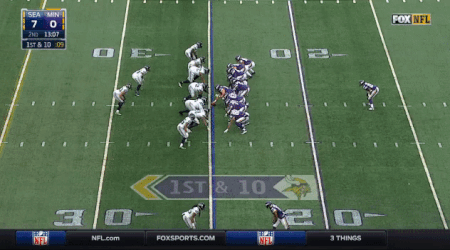
The Seahawks defense arguably had their best defensive performance of the season on that December day, which means even the Jimmy Clausen-led Bears had a better day than the Vikings.
In the 1st meeting, the #Seahawks held the #Vikings to 9 yds per drive, their most dominant performance of the year pic.twitter.com/P8PwDD8gRO
— ProFootballReference (@pfref) January 10, 2016
Though the Vikings defense improved a month after that beat down, the offense didn't. On Sunday, Bridgewater went 17 of 24 for 146 yards. Peterson averaged 2 yards per carry.
The Vikings scored 16 points on the Seahawks over the course of eight quarters. Their only touchdown came on a kickoff return.
5. Brrrrrr
Just three hours before kickoff, it was -9 degrees in Winterfell -- I mean Minneapolis. This is what it felt like at kickoff.
Official temp minus-6, wind chill minus-25 mph. #SEAvsMIN
— Dave Boling (@DaveBoling) January 10, 2016
That's the third coldest game in Pro Football Reference's database!
Richard Sherman says his contact lens almost froze solid
— Danny Kelly (@FieldGulls) January 10, 2016
The first causality? The Vikings' gjallarhorn, which you'd assume would have been built to endure cold weather. Nope -- it shattered before the game.
Shattered.
The #Vikings #Gjallarhorn is shattered from the cold temps before today's #SEAvsMIN game. pic.twitter.com/0MceMuekPl
— KARE 11 (@kare11) January 10, 2016
The players clearly felt the effects.
The Vikings' huddle is basically a steam room pic.twitter.com/mnlU1kfwyr
— ryan van bibber (@justRVB) January 10, 2016
5A. Doug Baldwin's catch
But Baldwin wasn't affected by the weather.
-6 degrees outside? Doug Baldwin doesn't care. He's too busy making leaping one-handed catches. #SEAvsMIN https://t.co/8pyWB1P8Ti
— NFL (@NFL) January 10, 2016
So, in three playoff games, DeAndre Hopkins, Martavis Bryant, and now Doug Baldwin have all submitted entries for the best catch of the playoffs.
6. What's next?
The Seahawks go to Carolina to play the top-seeded Panthers. Earlier this season, the Panthers pulled off a comeback win in Seattle, beating the Seahawks 27-23.
The bad news for the Seahawks is that they struggled mightily against tight ends and the Panthers have Greg Olsen, who caught 77 passes for 1,104 yards and seven touchdowns this season. Seattle finished the regular season 26th in DVOA against tight ends.
With that being said, the Seahawks are now just two wins away from making it to their third straight Super Bowl. No team has done that since the Bills pulled off four straight appearances in the early 1990s. The Dolphins are the only other team to make it to three straight Super Bowls (1971-1973).
Gather around this fire, boys. #SEAvsMIN #NFLPlayoffs pic.twitter.com/Vo4PfSfO8r
— Seattle Seahawks (@Seahawks) January 10, 2016








